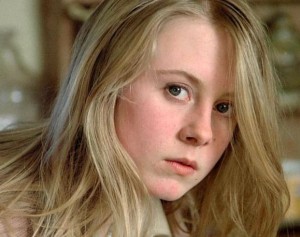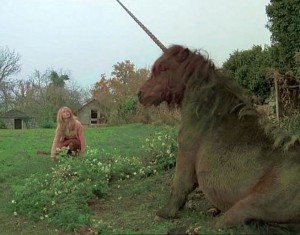 A strange and disturbingly incomprehensible concoction from 1975, Louis Malle’s Black Moon is — more or less, kind of, I think — the “story” of Lily, an attractive young creature who finds herself at a rather surreal country estate after fleeing what appears to be a shooting war between men and women.
A strange and disturbingly incomprehensible concoction from 1975, Louis Malle’s Black Moon is — more or less, kind of, I think — the “story” of Lily, an attractive young creature who finds herself at a rather surreal country estate after fleeing what appears to be a shooting war between men and women.
Beyond that there is not much that can be said for the plot — Malle himself admitted that as soon as he put something even close to a plot element down on paper he immediately crossed it out. Add to this deliberate lack of story and structure Malle’s admission that many scenes simply don’t work, and the result is a movie completely lacking in any meaning. Through the lack of any real story – Lily arrives at the house, weird things happen, the movie ends – the movie is deprived of a surface meaning, and if it has a deeper meaning it has escaped not only my rationalist attempts at deciphering it but also the attempts of critics who are well versed in the sort of obscure psychoanalytic symbolism used by Malle.
This is not to say that Black Moon is a bad movie, only that it is a meaningless one. Once the viewer gets accustomed to the idea that there is nothing to be understood the movie is quite enjoyable. The primary pleasure to be derived from Black Moon is the cinematography of Sven Niqvist, best known as Ingmar Bergman’s favorite cameraman. Using an autumnal palette and deliberately flat lighting, the cinematography showcases the beauty of the location while building a somewhat downbeat, dreamlike atmosphere. Admittedly, the setting itself has to take a fair amount of credit for the comeliness of the images — a large, ancient, grey stone house with ivy-covered patches, a thatched roof and surrounded on all sides by lush green countryside, the building is so memorable that it almost deserves its own place in the cast list.

An additional reason to watch Black Moon is its aforementioned weirdness. The farmhouse is inhabited not only by humans but also by animals, some of whom are able to speak. The most noteworthy of these talking creatures is Humphrey, a giant rat who holds frequent conversations with a batty old woman who never leaves her room. Unfortunately, the two insist in conversing in some language that exists only in Malle’s script so we have not idea what they are saying – yet another frustration for those trying to decipher the movie – but there’s no denying the enjoyable nuttiness of watching someone argue with a giant rodent. This latter is, as far as I can tell, played by a Gambian Pouched Rat, a real-life species that grows to the size of a housecat, and is not a special effect – given the poor state of FX in the seventies the real rat is much more effective.
The other notable talking animal is a unicorn who, unlike his rodent compatriot, is quite skillful with the English language, having graduated from Oxford with a degree in English Lit. A brown and somewhat tubby pony with a horn stuck to its head, this creature is usually taken to represent a sexual something or other. If nothing else, the unicorn’s presence, especially when combined with the snakes that young Lily keeps bumping into, suggests that something sexual is going on in the subtext. But that is as close as we are going to get to knowing what this hodge podge of a movie is saying. Chances are that it isn’t trying to say anything, and if you can live with that you will probably find Black Moon an enjoyable and dreamlike bit of surrealistic self-indulgence.